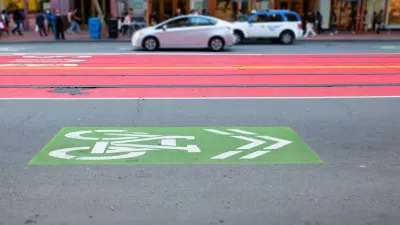A small section of the well-used, protected bike lane on San Francisco's busy Market Street will be raised just a few inches to increase bicycle safety. Construction began Monday and should take a month to complete.
ABC 7 reporter Amy Hollyfield reports from Market Street on Monday (Oct. 19) on the construction that has begun to raise the protected, green bikes lane a few inches for two blocks between Gough Street and 12th Street in the eastbound direction
Just as with protected bicycle intersections, the idea comes from similar lanes in Amsterdam. The purpose is to increase safety by more clearly delineating where cyclists and motorists use the road in addition to the buffer and flexible plastic bollards that separate the modes now. However, some cyclists interviewed expressed concern about the vertical separation between the auto and bike lanes.
Transportation officials aren't worried about people falling off of the raised lane "At this point, we think this is going to be a beneficial and positive thing for people riding bikes, people who are walking and people who are driving as well because it organizes the streets. What we're seeing here is just how high is comfortable and how low makes a difference," Muni spokesperson Paul Rose said.
Paolo Cosulich-Schwartz of the San Francisco Bicycle Coalition provides additional information on the safety objective of the raised lanes.
Regardless of what one may think about the usefulness of the measure, it's clear from the video that the bike lane is heavily used. "Transportation officials say since the number of people on bikes has grown 200 percent since 2006, they think something new is necessary," writes Hollyfield.
"Last year, California passed bill AB 1193 which formally defined raised bikeways and protected bike lanes as a new kind of bike facility in the California Vehicle Code," writes Bob Redell for NBC.
The Raised Bikeway Demonstration Project is also one of 24 priority safety projects that San Francisco promised to complete by February 2016 as part of Vision Zero, the city’s commitment to eliminate all traffic deaths by 2024.
FULL STORY: Bicycle Safety Changes Coming To Market Street In San Francisco

Alabama: Trump Terminates Settlements for Black Communities Harmed By Raw Sewage
Trump deemed the landmark civil rights agreement “illegal DEI and environmental justice policy.”

Study: Maui’s Plan to Convert Vacation Rentals to Long-Term Housing Could Cause Nearly $1 Billion Economic Loss
The plan would reduce visitor accommodation by 25% resulting in 1,900 jobs lost.

Why Should We Subsidize Public Transportation?
Many public transit agencies face financial stress due to rising costs, declining fare revenue, and declining subsidies. Transit advocates must provide a strong business case for increasing public transit funding.

Paris Bike Boom Leads to Steep Drop in Air Pollution
The French city’s air quality has improved dramatically in the past 20 years, coinciding with a growth in cycling.

Why Housing Costs More to Build in California Than in Texas
Hard costs like labor and materials combined with ‘soft’ costs such as permitting make building in the San Francisco Bay Area almost three times as costly as in Texas cities.

San Diego County Sees a Rise in Urban Coyotes
San Diego County experiences a rise in urban coyotes, as sightings become prevalent throughout its urban neighbourhoods and surrounding areas.
Urban Design for Planners 1: Software Tools
This six-course series explores essential urban design concepts using open source software and equips planners with the tools they need to participate fully in the urban design process.
Planning for Universal Design
Learn the tools for implementing Universal Design in planning regulations.
Smith Gee Studio
Alamo Area Metropolitan Planning Organization
City of Santa Clarita
Institute for Housing and Urban Development Studies (IHS)
City of Grandview
Harvard GSD Executive Education
Toledo-Lucas County Plan Commissions
Salt Lake City
NYU Wagner Graduate School of Public Service




























